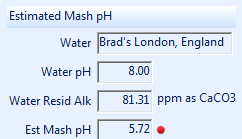
| DISCUSSION |īased on my multiple experiences with these beers, I was admittedly surprised by the results showing participants were able to reliably distinguish the batch sparge beer from its no sparge counterpart.

Kölsch being one of my favorite styles, I’ll certainly be brewing more, though in future iterations I plan to add a touch more Crystal malt and ferment a tad cooler. Visually, the beers are clearly different, in fact the batch sparge beer remained hazier than the no sparge version until the kegs kicked. I found both to be fine and easy-drinking, but they had a slightly stronger fruity ester than I typically prefer in this style, something I’m inclined to attribute to fermenting on the warmer end of recommended temperature range.

Obviously, this doesn’t align with the results, which is either an indication of my shitty palate or the fact these beers really weren’t all that different, just enough to be reliably distinguished by participants. My Impressions: I began tasting these beers sooner than the participants and I’ve never been able to distinguish them, despite knowing the variable. Another person noted the batch sparge beer left a slight lingering flavor in the back of their mouth. In chats with tasters after completing the survey, those who were correct on the triangle test had difficulty putting their finger on what about the beers were different. Some said they perceived the batch sparge beer as having a slightly different mouthfeel and “thinner” flavor than the no sparge sample. Still blind to the nature of the xBmt, 7 tasters said they preferred the batch sparge beer, 3 liked the no sparge beer more, another 3 said they had no preference despite noticing a difference, and 1 person reported noticing no difference. These results suggest participants were able to reliably distinguish a beer made using the batch sparge method from one produced using the no sparge method.įollowing completion of the triangle test, the 14 tasters who correctly identified the unique sample were asked to complete a brief preference survey. Given the sample size, 13 tasters (p<0.05) would have had to correctly identify the unique sample in order to achieve statistical significance, while 14 (p=0.02) were able to do so. Each taster, blind to the variable being investigated, was served 2 samples of the beer made using the batch sparge method and 1 sample of the beer made using the no sparge method in differently colored opaque cups then instructed to select the unique sample. Left: batch sparge | Right: no sparge | RESULTS |Ī panel of 26 members of the Aurora City Brew Club participated in this xBmt. Something about the warm Summer had me yearning for low alcohol yellow beer, so I decided to brew an easy drinking Kölsch for this xBmt, figuring it was light enough to allow any potential variable dependent differences to shine through. To evaluate the impact different mash methods have on beer, the same recipe was brewed simultaneously using either batch sparge or no sparge. However, I’ve never compared beers made using either method side-by-side, and since it seems more brewers are making the switch to no sparge methods, I figured it was good time to test it out! | PURPOSE |

As is often discussed, my no sparge batches tend to yield slightly lower efficiencies compared to when I batch sparge, but I can’t say I’ve ever noticed the finished beers as being all that different in terms of malt character or overall quality. In the interest of both speeding up my brew day and producing a beer with more malt character, I’ve tried my hand at the no sparge method numerous times, all successful to the extent that I made beer. Batch sparging (in which first, second and even third runnings are combined to produce the wort) can exacerbate this effect because all of the wort is drained away, including the majority of the buffering capability, before adding the next sparge volume. This rise in mash pH tends to extract greater proportions of tannins, polyphenols and silicates into the wort that have a dulling effect on the taste. As far back as 2002, John Palmer discussed the merits of this simplified all-grain approach to beer making in an article he penned for Brew Your Own, in which he states: At the end of the continuous sparging process, the mash pH typically rises to around 6 as the sugars are extracted and the buffering effect of the malt and wort is replaced by water.
#Grainfather beersmith mash profile full
Mosaic Of Change IPA by House Of PendragonĪ method that has seemed to experience a bump in popularity over the last few years, perhaps as a result of the growth of the Brew In A Bag (BIAB) movement, no sparge brewing involves eliminating the sparge step by mashing with the full volume of brewing liquor.


 0 kommentar(er)
0 kommentar(er)
